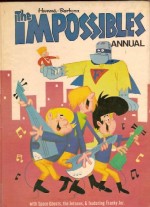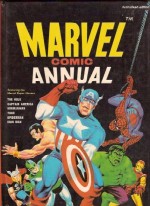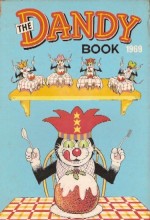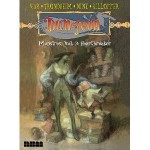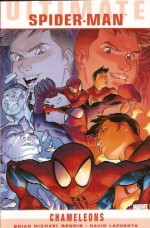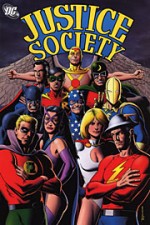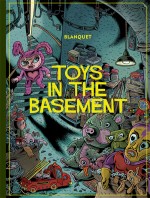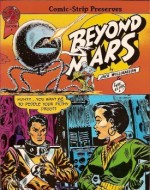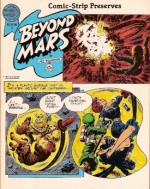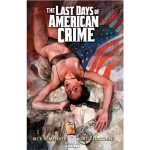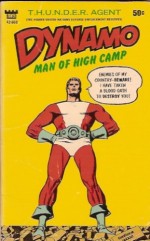
By Wally Wood & various (Tower Books)
ISBN: 42-660
I’ve often harped on about the mini-revolution in the “Camp-superhero†crazed 1960s that saw four-colour comicbook classics migrate briefly from flimsy pamphlet to the stiffened covers and relative respectability of the paperback bookshelves, and the nostalgic wonderments these mostly forgotten fancies still afford (to me at least), but here’s one that I picked up years later as a marginally mature grown man.
Although the double-sized colour comicbooks T.H.U.N.D.E.R. Agents, its spin-offs Undersea Agent, Dynamo, NoMan and the magnificent war-comic Fight the Enemy were all distributed in Britain (but not, I believe comedy title Tippy Teen) these monochrome, resized book editions, to the best of my knowledge, were not.
It doesn’t matter: to my delight, it seems that even today the format and not the glow of childhood days recalled is enough to spark that frisson of proprietary glee that apparently only comic fans (and Toy collectors) are preciously prone to.
Of course it doesn’t hurt when the material is as magnificent as this…
The history of Wally Wood’s immortal spies-in-tights masterpiece is convoluted, and once the mayfly-like lifetime of the Tower Comics line ended, not especially pretty as the material and rights bogged down in legal wrangling and petty back-biting, but that doesn’t diminish the fact that the far-too brief careers of The Higher United Nations Defense Enforcement Reserves was a benchmark of quality and sheer bravura fun for fans of both the reawakening superhero genre and the 1960s spy-chic obsession. Their sheer imaginative longevity is attested to by the fact that they’re back again now, courtesy of that Costumed Cut-ups Clearing House, DC Comics…
In the early 1960s the Bond movie franchise went from strength to strength, with action and glamour utterly transforming the formerly understated espionage vehicle. The buzz was infectious: soon Men like Flint and Matt Helm were carving out their own piece of the action as television shanghaied the entire bandwagon with the irresistible Man From U.N.C.L.E. (beginning in September 1964), bringing the whole genre inescapably into living rooms across the world.
Creative maverick Wally Wood was approached by veteran MLJ/Archie Comics editor Harry Shorten to create a line of characters for a new distribution-chain funded publishing outfit – Tower Comics. He, in turn called on many of the industry’s biggest names to produce material for the broad range of genres the company envisioned: Samm Schwartz and Dan DeCarlo handled Tippy Teen – which outlasted all the others – whilst Wood, Larry Ivie, Len Brown, Bill Pearson, Steve Skeates, Dan Adkins, Russ Jones, Gil Kane and Ralph Reese all contributed to the adventure series.
With a ravenous public appetite for super-spies and costumed heroes exponentially growing the idea of blending the two concepts seems a no-brainer now, but those were far more conservative times, so when T.H.U.N.D.E.R. Agents #1 appeared with no fanfare or pre-publicity on newsstands in August 1965 (with a cover off-sale date of November) thrill-hungry readers like little me were blown away. It didn’t hurt either that all Tower titles were in the beloved-but-rarely-seen 80 Page Giant format: there was a huge amount to read in every issue!
All that being said the strips would not be so revered if they hadn’t been so superbly crafted. As well as Wood, the art accompanying the compelling and generally mature stories was by some of the greatest talents in the business: Reed Crandall, Gil Kane, George Tuska, Mike Sekowsky, Dick Ayers, Joe Orlando, Frank Giacoia, John Giunta, Steve Ditko and others.
This slim, seductive digest stars the UN Agency’s Ace troubleshooter and all-round Ordinary Guy Len Brown in five staggering spy thrillers featuring a winning combination of cloak-and-dagger danger, science fiction shocks and stirring super-heroics which also includes the origins of aforementioned fellow operatives NoMan and Menthor.
It all starts with a simple fast-paced introductory tale ‘First Encounter’ by Ivie & Wood, wherein UN commandos failed to save brilliant scientist Professor Emil Jennings from the attack of the mysterious Warlord, but at least rescued some of his greatest inventions, including a belt that increases the wearer’s density until the body becomes as hard as steel, an invisibility cloak and an enigmatic brain-amplifier helmet.
For security purposes these prototype weapons were divided between several agents to create a unit of superior fighting men and counter the increasingly bold attacks of global terror threats.
First chosen was affable file-clerk Len Brown who was, to everyone’s surprise, assigned the belt and the codename Dynamo in a delightfully light-hearted adventure ‘Menace of the Iron Fog’ (written by Len Brown, who had no idea illustrator/editor Wood had prankishly changed the hero’s civilian name as a last-minute gag) which gloriously depicted every kid’s dream as the not-so-smart nice guy got the irresistible power to smash stuff. This cathartic fun-fest also introduced Iron Maiden, a sultry villainess clad in figure-hugging steel who was the probable puberty trigger for an entire generation…
‘T.H.U.N.D.E.R. Agent NoMan Battles the Spawns of the Devil’ follows: the eerie saga of aged Dr. Anthony Dunn who chose to have his mind transferred into an android body, then equipped with the invisibility cape. The author is unknown but the incredible Reed Crandall (with supplemental Wood inks) drew this breathtaking rollercoaster adventure which also found time and space to include a captivating clash with sinister mastermind Demo and his sultry associate Satana who had unleashed a wave of bestial sub-men on a modern metropolis. NoMan had one final advantage: if his artificial body was destroyed his consciousness could transfer to another android body. As long as he had a spare ready, he could never die…
The third agent was chosen in ‘The Enemy Within’ (also with no script credit and illustrated by Gil Kane, Mike Esposito and George Tuska). However here the creators stepped well outside comic-book conventions: John Janus was the perfect UN employee – a mental and physical marvel who easily passed all the necessary tests and was selected to wear the Jennings helmet. Sadly, he was also a deep-cover mole for the Warlord, poised to betray T.H.U.N.D.E.R. at the earliest opportunity…
All plans went awry once he donned the helmet and became Menthor. The device awakened the potential of his mind, granting him telepathy, telekinesis and mid-reading powers – and also drove the capacity for evil from his mind whilst he wore it. When the warlord attacked with a small army and a giant monster, Menthor was compelled by his own costume to defeat the assault. What a dilemma for a traitor to be in…
All the tales in this diminutive paperback gem were taken from the first comicbook issue of T.H.U.N.D.E.R. Agents and although some features were left out, the spectacular old-fashioned team-up of the disparate forces of the Agency, assembled to rescue their prime agent who was ‘At the Mercy of the Iron Maiden’ (by Brown, Wood & Dan Adkins) remains, a magnificent battle blockbuster that still takes the breath away, even resized reformatted and in black and white.
To be honest the sheer artist quality of the creators is actually enhanced by removing the often hit-or-miss colour of 1960s comics, and these truly timeless tales only improve with every reading – and there’s precious few things you can say that about…
© 1965, 1966 Tower Comics, Inc. All rights reserved.

